BSBLDR502 Project Submission
VerifiedAdded on 2020/03/07
|17
|5789
|79
Project
AI Summary
This project submission for BSBLDR502 requires students to demonstrate their understanding of effective workplace relationships and team management. The assessment includes various components such as a cover sheet, candidate declaration, assessment guidelines, and specific questions related to managing teams and workplace dynamics. Students must complete all sections and submit the document for evaluation.
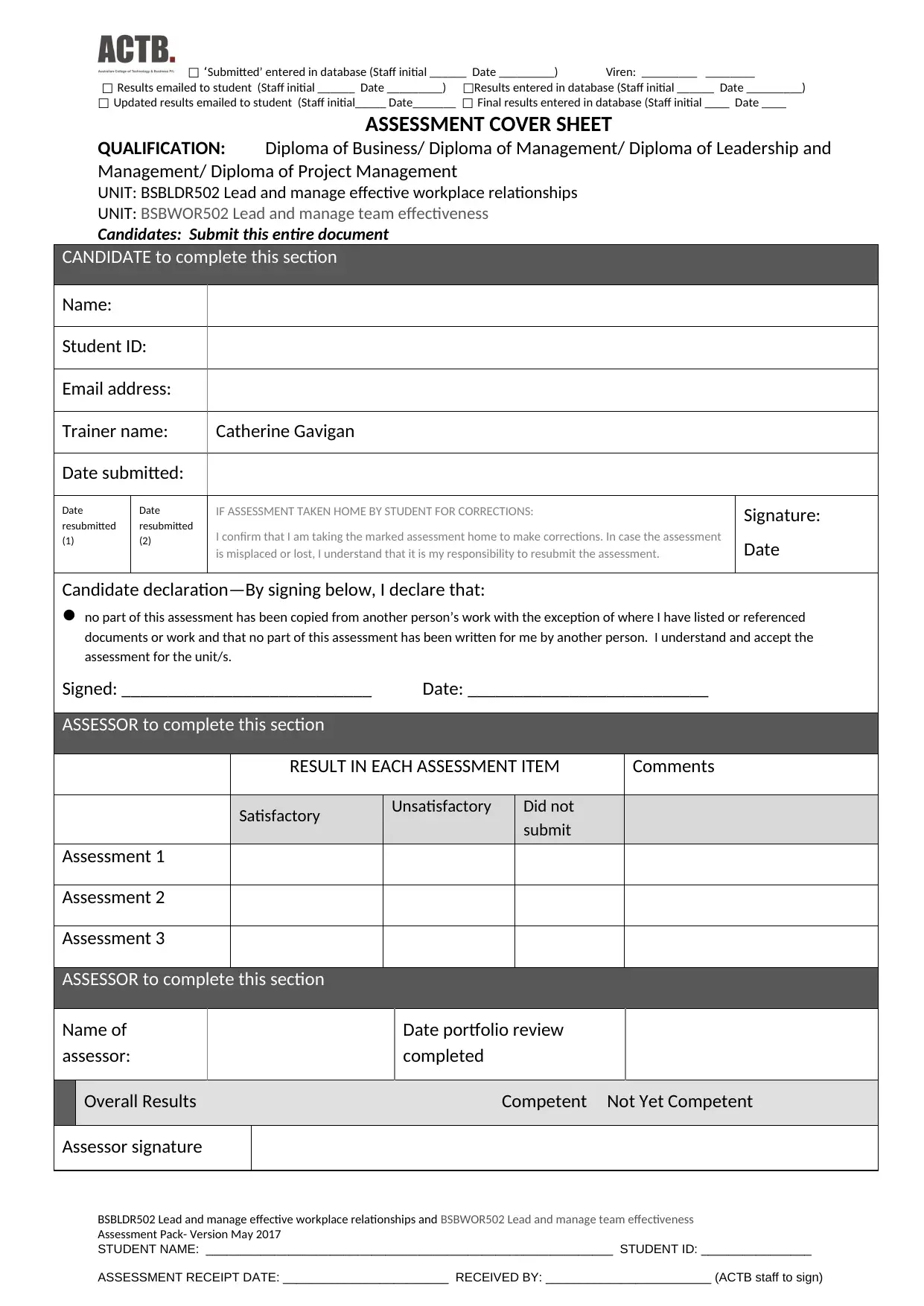
□ ‘Submitted’ entered in database (Staff initial ______ Date _________) Viren: _________ ________
□ Results emailed to student (Staff initial ______ Date _________) □Results entered in database (Staff initial ______ Date _________)
□ Updated results emailed to student (Staff initial_____ Date_______ □ Final results entered in database (Staff initial ____ Date ____
ASSESSMENT COVER SHEET
QUALIFICATION: Diploma of Business/ Diploma of Management/ Diploma of Leadership and
Management/ Diploma of Project Management
UNIT: BSBLDR502 Lead and manage effective workplace relationships
UNIT: BSBWOR502 Lead and manage team effectiveness
Candidates: Submit this entire document
CANDIDATE to complete this section
Name:
Student ID:
Email address:
Trainer name: Catherine Gavigan
Date submitted:
Date
resubmitted
(1)
Date
resubmitted
(2)
IF ASSESSMENT TAKEN HOME BY STUDENT FOR CORRECTIONS:
I confirm that I am taking the marked assessment home to make corrections. In case the assessment
is misplaced or lost, I understand that it is my responsibility to resubmit the assessment.
Signature:
Date
Candidate declaration—By signing below, I declare that:
no part of this assessment has been copied from another person’s work with the exception of where I have listed or referenced
documents or work and that no part of this assessment has been written for me by another person. I understand and accept the
assessment for the unit/s.
Signed: ___________________________ Date: __________________________
ASSESSOR to complete this section
RESULT IN EACH ASSESSMENT ITEM Comments
Satisfactory Unsatisfactory Did not
submit
Assessment 1
Assessment 2
Assessment 3
ASSESSOR to complete this section
Name of
assessor:
Date portfolio review
completed
Overall Results Competent Not Yet Competent
Assessor signature
BSBLDR502 Lead and manage effective workplace relationships and BSBWOR502 Lead and manage team effectiveness
Assessment Pack- Version May 2017
STUDENT NAME: ___________________________________________________________ STUDENT ID: ________________
ASSESSMENT RECEIPT DATE: ________________________ RECEIVED BY: ________________________ (ACTB staff to sign)
□ Results emailed to student (Staff initial ______ Date _________) □Results entered in database (Staff initial ______ Date _________)
□ Updated results emailed to student (Staff initial_____ Date_______ □ Final results entered in database (Staff initial ____ Date ____
ASSESSMENT COVER SHEET
QUALIFICATION: Diploma of Business/ Diploma of Management/ Diploma of Leadership and
Management/ Diploma of Project Management
UNIT: BSBLDR502 Lead and manage effective workplace relationships
UNIT: BSBWOR502 Lead and manage team effectiveness
Candidates: Submit this entire document
CANDIDATE to complete this section
Name:
Student ID:
Email address:
Trainer name: Catherine Gavigan
Date submitted:
Date
resubmitted
(1)
Date
resubmitted
(2)
IF ASSESSMENT TAKEN HOME BY STUDENT FOR CORRECTIONS:
I confirm that I am taking the marked assessment home to make corrections. In case the assessment
is misplaced or lost, I understand that it is my responsibility to resubmit the assessment.
Signature:
Date
Candidate declaration—By signing below, I declare that:
no part of this assessment has been copied from another person’s work with the exception of where I have listed or referenced
documents or work and that no part of this assessment has been written for me by another person. I understand and accept the
assessment for the unit/s.
Signed: ___________________________ Date: __________________________
ASSESSOR to complete this section
RESULT IN EACH ASSESSMENT ITEM Comments
Satisfactory Unsatisfactory Did not
submit
Assessment 1
Assessment 2
Assessment 3
ASSESSOR to complete this section
Name of
assessor:
Date portfolio review
completed
Overall Results Competent Not Yet Competent
Assessor signature
BSBLDR502 Lead and manage effective workplace relationships and BSBWOR502 Lead and manage team effectiveness
Assessment Pack- Version May 2017
STUDENT NAME: ___________________________________________________________ STUDENT ID: ________________
ASSESSMENT RECEIPT DATE: ________________________ RECEIVED BY: ________________________ (ACTB staff to sign)
Paraphrase This Document
Need a fresh take? Get an instant paraphrase of this document with our AI Paraphraser
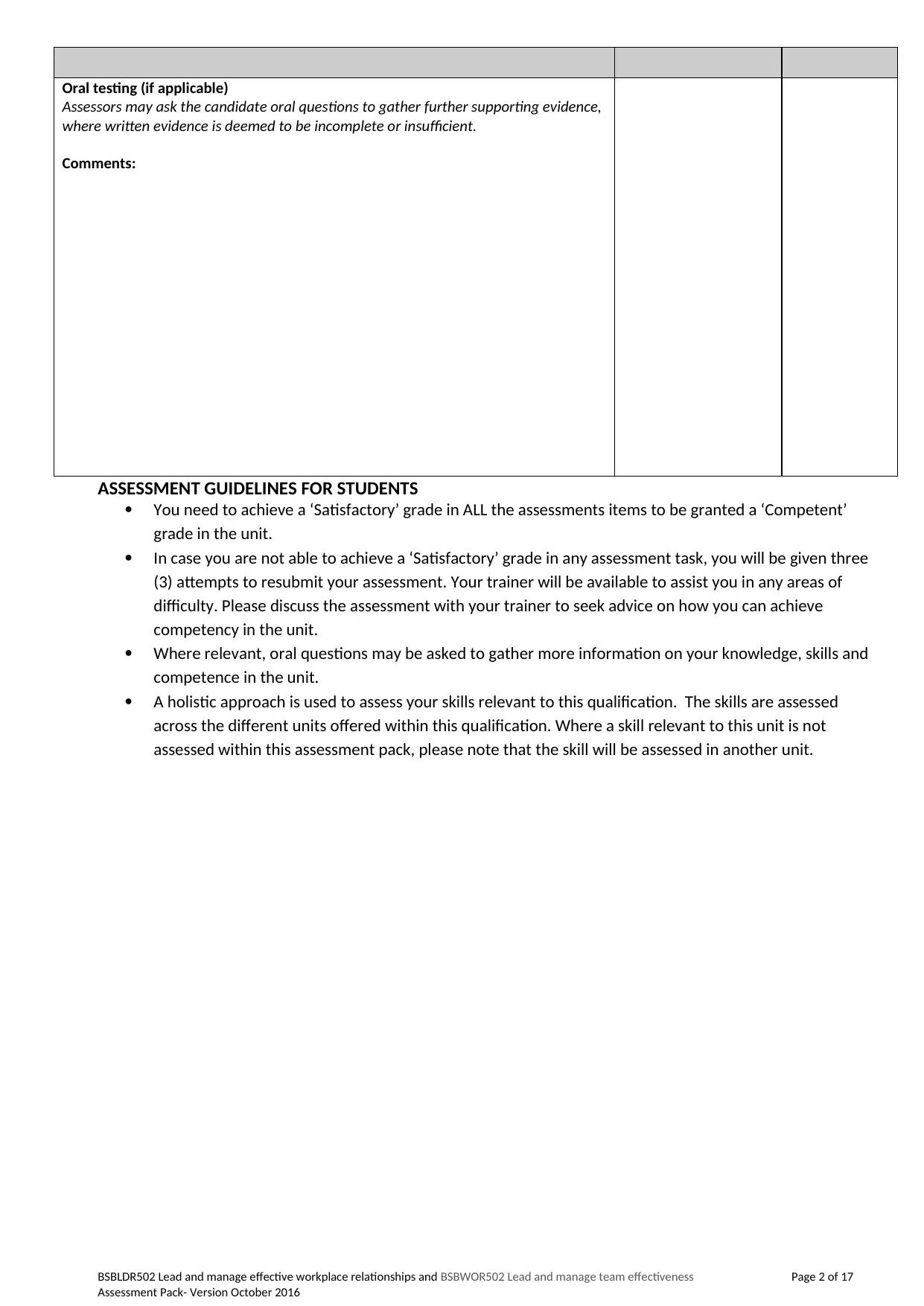
Oral testing (if applicable)
Assessors may ask the candidate oral questions to gather further supporting evidence,
where written evidence is deemed to be incomplete or insufficient.
Comments:
ASSESSMENT GUIDELINES FOR STUDENTS
You need to achieve a ‘Satisfactory’ grade in ALL the assessments items to be granted a ‘Competent’
grade in the unit.
In case you are not able to achieve a ‘Satisfactory’ grade in any assessment task, you will be given three
(3) attempts to resubmit your assessment. Your trainer will be available to assist you in any areas of
difficulty. Please discuss the assessment with your trainer to seek advice on how you can achieve
competency in the unit.
Where relevant, oral questions may be asked to gather more information on your knowledge, skills and
competence in the unit.
A holistic approach is used to assess your skills relevant to this qualification. The skills are assessed
across the different units offered within this qualification. Where a skill relevant to this unit is not
assessed within this assessment pack, please note that the skill will be assessed in another unit.
BSBLDR502 Lead and manage effective workplace relationships and BSBWOR502 Lead and manage team effectiveness
Assessment Pack- Version October 2016
Page 2 of 17
Assessors may ask the candidate oral questions to gather further supporting evidence,
where written evidence is deemed to be incomplete or insufficient.
Comments:
ASSESSMENT GUIDELINES FOR STUDENTS
You need to achieve a ‘Satisfactory’ grade in ALL the assessments items to be granted a ‘Competent’
grade in the unit.
In case you are not able to achieve a ‘Satisfactory’ grade in any assessment task, you will be given three
(3) attempts to resubmit your assessment. Your trainer will be available to assist you in any areas of
difficulty. Please discuss the assessment with your trainer to seek advice on how you can achieve
competency in the unit.
Where relevant, oral questions may be asked to gather more information on your knowledge, skills and
competence in the unit.
A holistic approach is used to assess your skills relevant to this qualification. The skills are assessed
across the different units offered within this qualification. Where a skill relevant to this unit is not
assessed within this assessment pack, please note that the skill will be assessed in another unit.
BSBLDR502 Lead and manage effective workplace relationships and BSBWOR502 Lead and manage team effectiveness
Assessment Pack- Version October 2016
Page 2 of 17
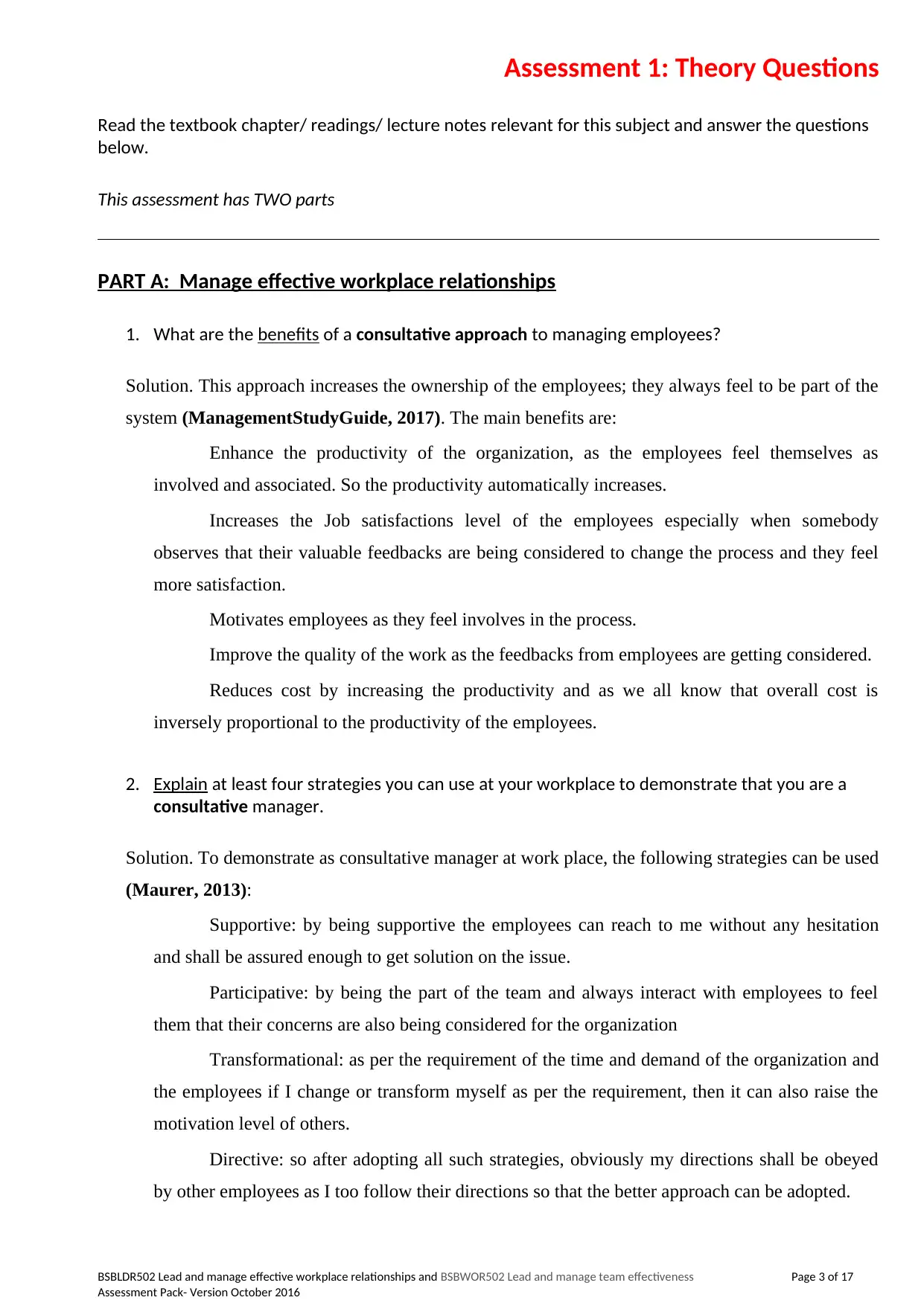
Assessment 1: Theory Questions
Read the textbook chapter/ readings/ lecture notes relevant for this subject and answer the questions
below.
This assessment has TWO parts
PART A: Manage effective workplace relationships
1. What are the benefits of a consultative approach to managing employees?
Solution. This approach increases the ownership of the employees; they always feel to be part of the
system (ManagementStudyGuide, 2017). The main benefits are:
Enhance the productivity of the organization, as the employees feel themselves as
involved and associated. So the productivity automatically increases.
Increases the Job satisfactions level of the employees especially when somebody
observes that their valuable feedbacks are being considered to change the process and they feel
more satisfaction.
Motivates employees as they feel involves in the process.
Improve the quality of the work as the feedbacks from employees are getting considered.
Reduces cost by increasing the productivity and as we all know that overall cost is
inversely proportional to the productivity of the employees.
2. Explain at least four strategies you can use at your workplace to demonstrate that you are a
consultative manager.
Solution. To demonstrate as consultative manager at work place, the following strategies can be used
(Maurer, 2013):
Supportive: by being supportive the employees can reach to me without any hesitation
and shall be assured enough to get solution on the issue.
Participative: by being the part of the team and always interact with employees to feel
them that their concerns are also being considered for the organization
Transformational: as per the requirement of the time and demand of the organization and
the employees if I change or transform myself as per the requirement, then it can also raise the
motivation level of others.
Directive: so after adopting all such strategies, obviously my directions shall be obeyed
by other employees as I too follow their directions so that the better approach can be adopted.
BSBLDR502 Lead and manage effective workplace relationships and BSBWOR502 Lead and manage team effectiveness
Assessment Pack- Version October 2016
Page 3 of 17
Read the textbook chapter/ readings/ lecture notes relevant for this subject and answer the questions
below.
This assessment has TWO parts
PART A: Manage effective workplace relationships
1. What are the benefits of a consultative approach to managing employees?
Solution. This approach increases the ownership of the employees; they always feel to be part of the
system (ManagementStudyGuide, 2017). The main benefits are:
Enhance the productivity of the organization, as the employees feel themselves as
involved and associated. So the productivity automatically increases.
Increases the Job satisfactions level of the employees especially when somebody
observes that their valuable feedbacks are being considered to change the process and they feel
more satisfaction.
Motivates employees as they feel involves in the process.
Improve the quality of the work as the feedbacks from employees are getting considered.
Reduces cost by increasing the productivity and as we all know that overall cost is
inversely proportional to the productivity of the employees.
2. Explain at least four strategies you can use at your workplace to demonstrate that you are a
consultative manager.
Solution. To demonstrate as consultative manager at work place, the following strategies can be used
(Maurer, 2013):
Supportive: by being supportive the employees can reach to me without any hesitation
and shall be assured enough to get solution on the issue.
Participative: by being the part of the team and always interact with employees to feel
them that their concerns are also being considered for the organization
Transformational: as per the requirement of the time and demand of the organization and
the employees if I change or transform myself as per the requirement, then it can also raise the
motivation level of others.
Directive: so after adopting all such strategies, obviously my directions shall be obeyed
by other employees as I too follow their directions so that the better approach can be adopted.
BSBLDR502 Lead and manage effective workplace relationships and BSBWOR502 Lead and manage team effectiveness
Assessment Pack- Version October 2016
Page 3 of 17
⊘ This is a preview!⊘
Do you want full access?
Subscribe today to unlock all pages.

Trusted by 1+ million students worldwide
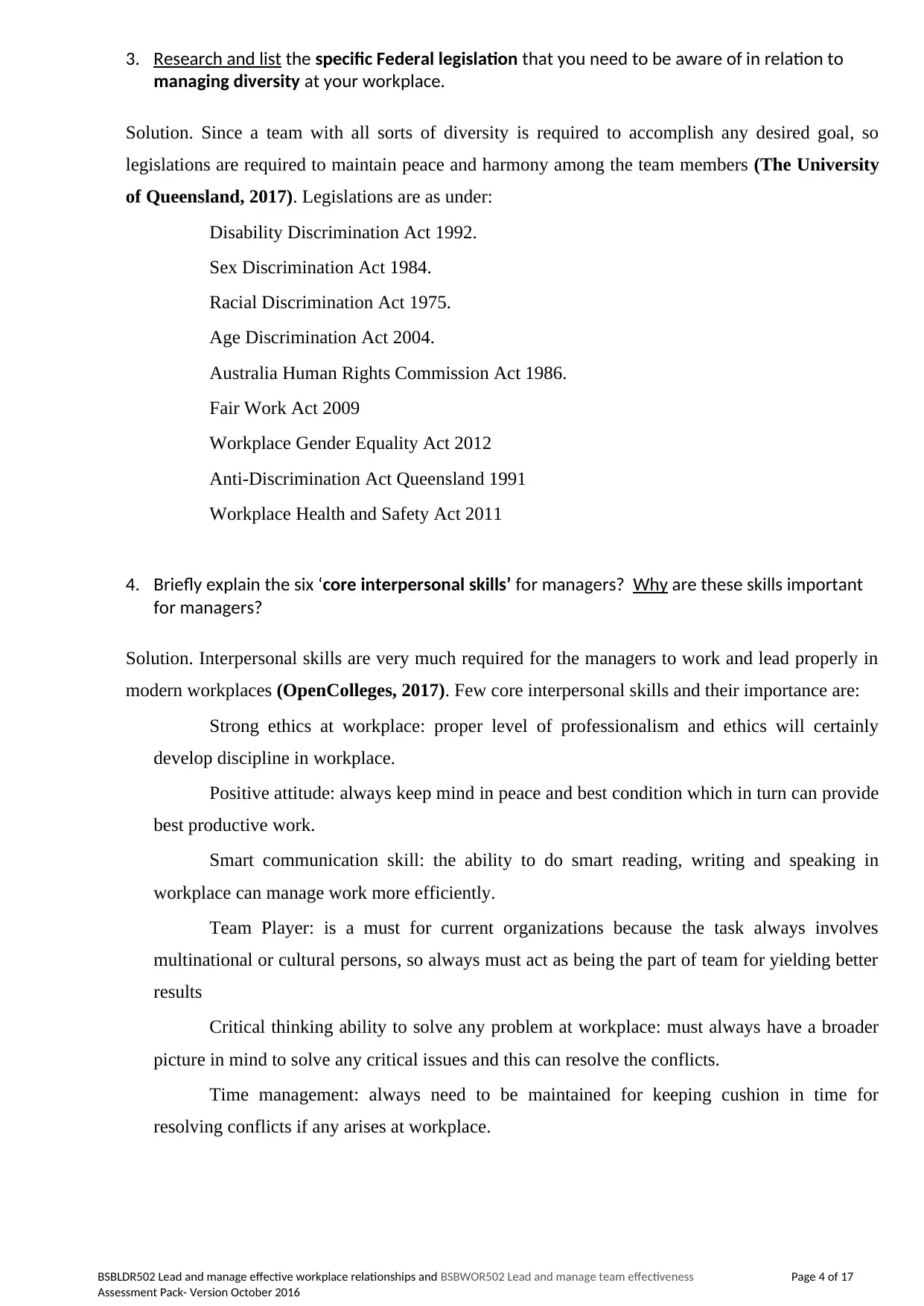
3. Research and list the specific Federal legislation that you need to be aware of in relation to
managing diversity at your workplace.
Solution. Since a team with all sorts of diversity is required to accomplish any desired goal, so
legislations are required to maintain peace and harmony among the team members (The University
of Queensland, 2017). Legislations are as under:
Disability Discrimination Act 1992.
Sex Discrimination Act 1984.
Racial Discrimination Act 1975.
Age Discrimination Act 2004.
Australia Human Rights Commission Act 1986.
Fair Work Act 2009
Workplace Gender Equality Act 2012
Anti-Discrimination Act Queensland 1991
Workplace Health and Safety Act 2011
4. Briefly explain the six ‘core interpersonal skills’ for managers? Why are these skills important
for managers?
Solution. Interpersonal skills are very much required for the managers to work and lead properly in
modern workplaces (OpenColleges, 2017). Few core interpersonal skills and their importance are:
Strong ethics at workplace: proper level of professionalism and ethics will certainly
develop discipline in workplace.
Positive attitude: always keep mind in peace and best condition which in turn can provide
best productive work.
Smart communication skill: the ability to do smart reading, writing and speaking in
workplace can manage work more efficiently.
Team Player: is a must for current organizations because the task always involves
multinational or cultural persons, so always must act as being the part of team for yielding better
results
Critical thinking ability to solve any problem at workplace: must always have a broader
picture in mind to solve any critical issues and this can resolve the conflicts.
Time management: always need to be maintained for keeping cushion in time for
resolving conflicts if any arises at workplace.
BSBLDR502 Lead and manage effective workplace relationships and BSBWOR502 Lead and manage team effectiveness
Assessment Pack- Version October 2016
Page 4 of 17
managing diversity at your workplace.
Solution. Since a team with all sorts of diversity is required to accomplish any desired goal, so
legislations are required to maintain peace and harmony among the team members (The University
of Queensland, 2017). Legislations are as under:
Disability Discrimination Act 1992.
Sex Discrimination Act 1984.
Racial Discrimination Act 1975.
Age Discrimination Act 2004.
Australia Human Rights Commission Act 1986.
Fair Work Act 2009
Workplace Gender Equality Act 2012
Anti-Discrimination Act Queensland 1991
Workplace Health and Safety Act 2011
4. Briefly explain the six ‘core interpersonal skills’ for managers? Why are these skills important
for managers?
Solution. Interpersonal skills are very much required for the managers to work and lead properly in
modern workplaces (OpenColleges, 2017). Few core interpersonal skills and their importance are:
Strong ethics at workplace: proper level of professionalism and ethics will certainly
develop discipline in workplace.
Positive attitude: always keep mind in peace and best condition which in turn can provide
best productive work.
Smart communication skill: the ability to do smart reading, writing and speaking in
workplace can manage work more efficiently.
Team Player: is a must for current organizations because the task always involves
multinational or cultural persons, so always must act as being the part of team for yielding better
results
Critical thinking ability to solve any problem at workplace: must always have a broader
picture in mind to solve any critical issues and this can resolve the conflicts.
Time management: always need to be maintained for keeping cushion in time for
resolving conflicts if any arises at workplace.
BSBLDR502 Lead and manage effective workplace relationships and BSBWOR502 Lead and manage team effectiveness
Assessment Pack- Version October 2016
Page 4 of 17
Paraphrase This Document
Need a fresh take? Get an instant paraphrase of this document with our AI Paraphraser
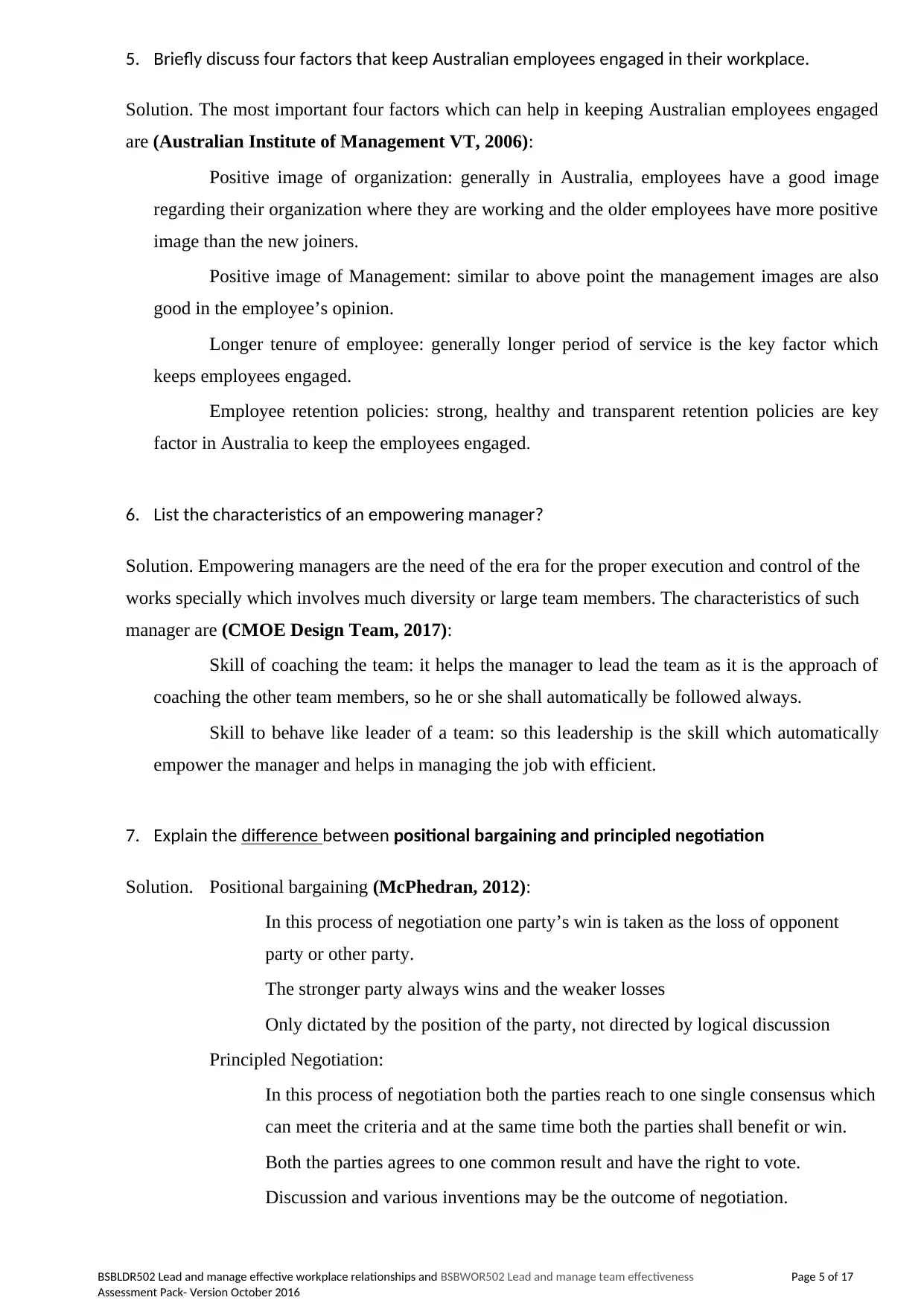
5. Briefly discuss four factors that keep Australian employees engaged in their workplace.
Solution. The most important four factors which can help in keeping Australian employees engaged
are (Australian Institute of Management VT, 2006):
Positive image of organization: generally in Australia, employees have a good image
regarding their organization where they are working and the older employees have more positive
image than the new joiners.
Positive image of Management: similar to above point the management images are also
good in the employee’s opinion.
Longer tenure of employee: generally longer period of service is the key factor which
keeps employees engaged.
Employee retention policies: strong, healthy and transparent retention policies are key
factor in Australia to keep the employees engaged.
6. List the characteristics of an empowering manager?
Solution. Empowering managers are the need of the era for the proper execution and control of the
works specially which involves much diversity or large team members. The characteristics of such
manager are (CMOE Design Team, 2017):
Skill of coaching the team: it helps the manager to lead the team as it is the approach of
coaching the other team members, so he or she shall automatically be followed always.
Skill to behave like leader of a team: so this leadership is the skill which automatically
empower the manager and helps in managing the job with efficient.
7. Explain the difference between positional bargaining and principled negotiation
Solution. Positional bargaining (McPhedran, 2012):
In this process of negotiation one party’s win is taken as the loss of opponent
party or other party.
The stronger party always wins and the weaker losses
Only dictated by the position of the party, not directed by logical discussion
Principled Negotiation:
In this process of negotiation both the parties reach to one single consensus which
can meet the criteria and at the same time both the parties shall benefit or win.
Both the parties agrees to one common result and have the right to vote.
Discussion and various inventions may be the outcome of negotiation.
BSBLDR502 Lead and manage effective workplace relationships and BSBWOR502 Lead and manage team effectiveness
Assessment Pack- Version October 2016
Page 5 of 17
Solution. The most important four factors which can help in keeping Australian employees engaged
are (Australian Institute of Management VT, 2006):
Positive image of organization: generally in Australia, employees have a good image
regarding their organization where they are working and the older employees have more positive
image than the new joiners.
Positive image of Management: similar to above point the management images are also
good in the employee’s opinion.
Longer tenure of employee: generally longer period of service is the key factor which
keeps employees engaged.
Employee retention policies: strong, healthy and transparent retention policies are key
factor in Australia to keep the employees engaged.
6. List the characteristics of an empowering manager?
Solution. Empowering managers are the need of the era for the proper execution and control of the
works specially which involves much diversity or large team members. The characteristics of such
manager are (CMOE Design Team, 2017):
Skill of coaching the team: it helps the manager to lead the team as it is the approach of
coaching the other team members, so he or she shall automatically be followed always.
Skill to behave like leader of a team: so this leadership is the skill which automatically
empower the manager and helps in managing the job with efficient.
7. Explain the difference between positional bargaining and principled negotiation
Solution. Positional bargaining (McPhedran, 2012):
In this process of negotiation one party’s win is taken as the loss of opponent
party or other party.
The stronger party always wins and the weaker losses
Only dictated by the position of the party, not directed by logical discussion
Principled Negotiation:
In this process of negotiation both the parties reach to one single consensus which
can meet the criteria and at the same time both the parties shall benefit or win.
Both the parties agrees to one common result and have the right to vote.
Discussion and various inventions may be the outcome of negotiation.
BSBLDR502 Lead and manage effective workplace relationships and BSBWOR502 Lead and manage team effectiveness
Assessment Pack- Version October 2016
Page 5 of 17
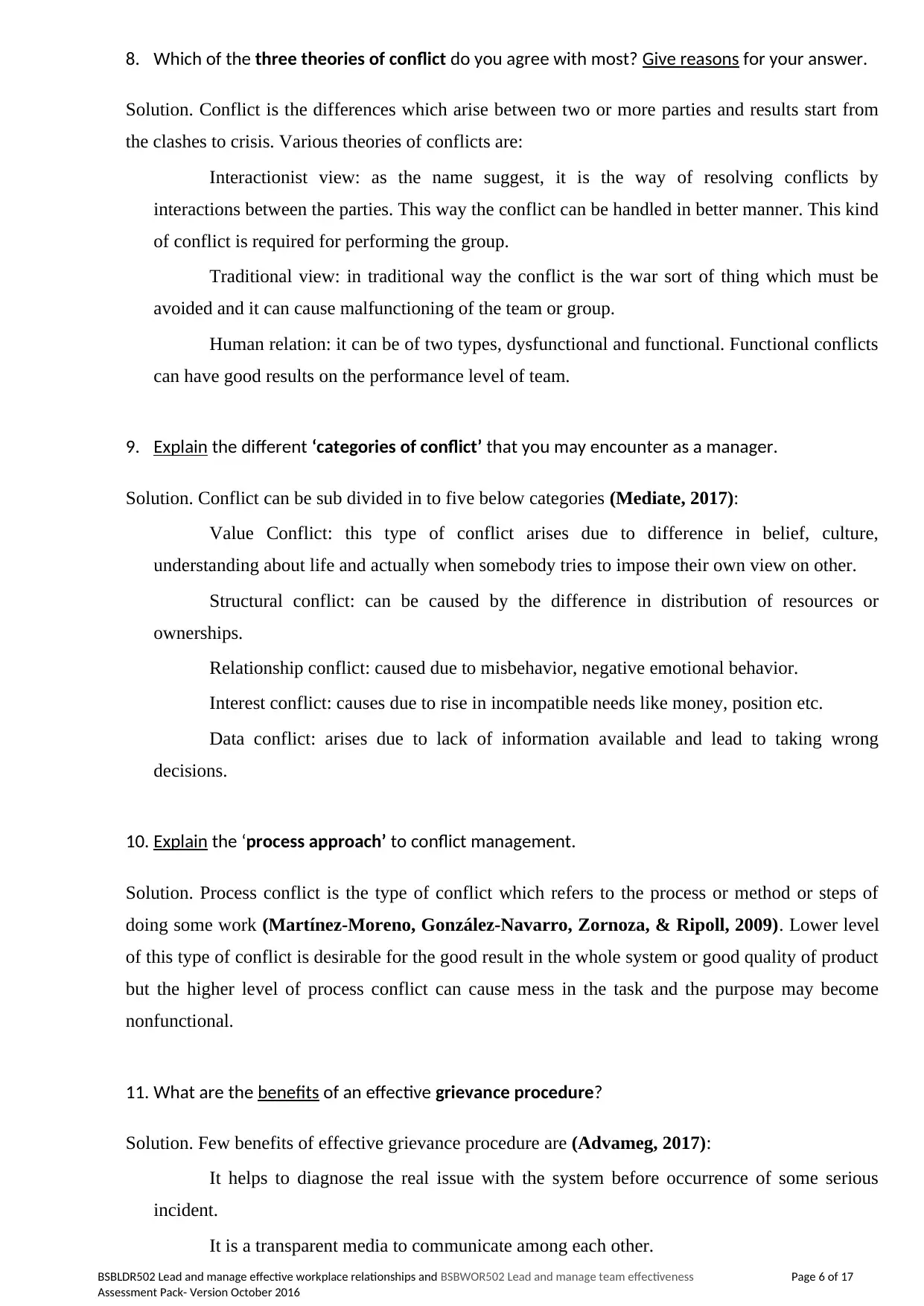
8. Which of the three theories of conflict do you agree with most? Give reasons for your answer.
Solution. Conflict is the differences which arise between two or more parties and results start from
the clashes to crisis. Various theories of conflicts are:
Interactionist view: as the name suggest, it is the way of resolving conflicts by
interactions between the parties. This way the conflict can be handled in better manner. This kind
of conflict is required for performing the group.
Traditional view: in traditional way the conflict is the war sort of thing which must be
avoided and it can cause malfunctioning of the team or group.
Human relation: it can be of two types, dysfunctional and functional. Functional conflicts
can have good results on the performance level of team.
9. Explain the different ‘categories of conflict’ that you may encounter as a manager.
Solution. Conflict can be sub divided in to five below categories (Mediate, 2017):
Value Conflict: this type of conflict arises due to difference in belief, culture,
understanding about life and actually when somebody tries to impose their own view on other.
Structural conflict: can be caused by the difference in distribution of resources or
ownerships.
Relationship conflict: caused due to misbehavior, negative emotional behavior.
Interest conflict: causes due to rise in incompatible needs like money, position etc.
Data conflict: arises due to lack of information available and lead to taking wrong
decisions.
10. Explain the ‘process approach’ to conflict management.
Solution. Process conflict is the type of conflict which refers to the process or method or steps of
doing some work (Martínez‐Moreno, González‐Navarro, Zornoza, & Ripoll, 2009). Lower level
of this type of conflict is desirable for the good result in the whole system or good quality of product
but the higher level of process conflict can cause mess in the task and the purpose may become
nonfunctional.
11. What are the benefits of an effective grievance procedure?
Solution. Few benefits of effective grievance procedure are (Advameg, 2017):
It helps to diagnose the real issue with the system before occurrence of some serious
incident.
It is a transparent media to communicate among each other.
BSBLDR502 Lead and manage effective workplace relationships and BSBWOR502 Lead and manage team effectiveness
Assessment Pack- Version October 2016
Page 6 of 17
Solution. Conflict is the differences which arise between two or more parties and results start from
the clashes to crisis. Various theories of conflicts are:
Interactionist view: as the name suggest, it is the way of resolving conflicts by
interactions between the parties. This way the conflict can be handled in better manner. This kind
of conflict is required for performing the group.
Traditional view: in traditional way the conflict is the war sort of thing which must be
avoided and it can cause malfunctioning of the team or group.
Human relation: it can be of two types, dysfunctional and functional. Functional conflicts
can have good results on the performance level of team.
9. Explain the different ‘categories of conflict’ that you may encounter as a manager.
Solution. Conflict can be sub divided in to five below categories (Mediate, 2017):
Value Conflict: this type of conflict arises due to difference in belief, culture,
understanding about life and actually when somebody tries to impose their own view on other.
Structural conflict: can be caused by the difference in distribution of resources or
ownerships.
Relationship conflict: caused due to misbehavior, negative emotional behavior.
Interest conflict: causes due to rise in incompatible needs like money, position etc.
Data conflict: arises due to lack of information available and lead to taking wrong
decisions.
10. Explain the ‘process approach’ to conflict management.
Solution. Process conflict is the type of conflict which refers to the process or method or steps of
doing some work (Martínez‐Moreno, González‐Navarro, Zornoza, & Ripoll, 2009). Lower level
of this type of conflict is desirable for the good result in the whole system or good quality of product
but the higher level of process conflict can cause mess in the task and the purpose may become
nonfunctional.
11. What are the benefits of an effective grievance procedure?
Solution. Few benefits of effective grievance procedure are (Advameg, 2017):
It helps to diagnose the real issue with the system before occurrence of some serious
incident.
It is a transparent media to communicate among each other.
BSBLDR502 Lead and manage effective workplace relationships and BSBWOR502 Lead and manage team effectiveness
Assessment Pack- Version October 2016
Page 6 of 17
⊘ This is a preview!⊘
Do you want full access?
Subscribe today to unlock all pages.

Trusted by 1+ million students worldwide
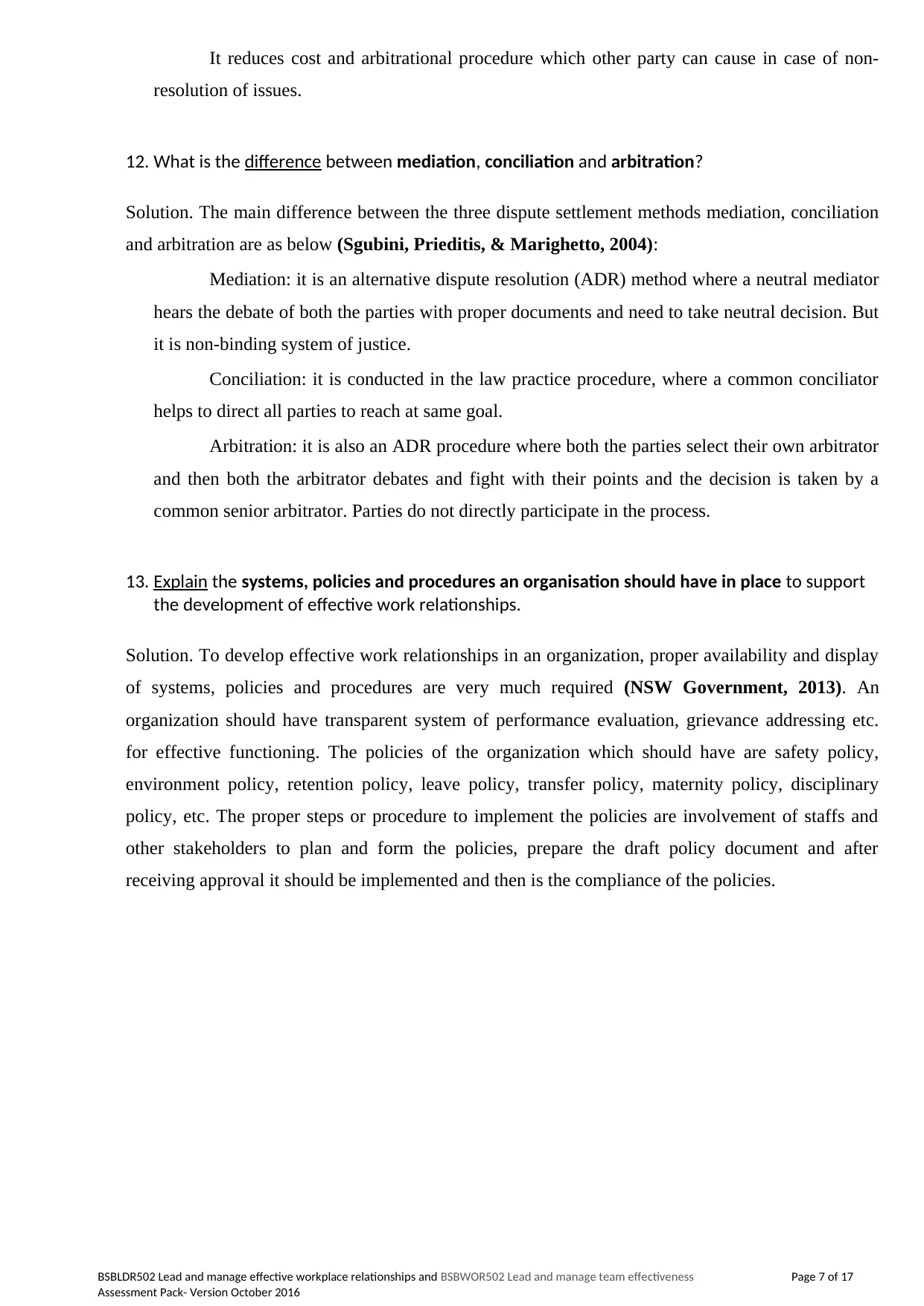
It reduces cost and arbitrational procedure which other party can cause in case of non-
resolution of issues.
12. What is the difference between mediation, conciliation and arbitration?
Solution. The main difference between the three dispute settlement methods mediation, conciliation
and arbitration are as below (Sgubini, Prieditis, & Marighetto, 2004):
Mediation: it is an alternative dispute resolution (ADR) method where a neutral mediator
hears the debate of both the parties with proper documents and need to take neutral decision. But
it is non-binding system of justice.
Conciliation: it is conducted in the law practice procedure, where a common conciliator
helps to direct all parties to reach at same goal.
Arbitration: it is also an ADR procedure where both the parties select their own arbitrator
and then both the arbitrator debates and fight with their points and the decision is taken by a
common senior arbitrator. Parties do not directly participate in the process.
13. Explain the systems, policies and procedures an organisation should have in place to support
the development of effective work relationships.
Solution. To develop effective work relationships in an organization, proper availability and display
of systems, policies and procedures are very much required (NSW Government, 2013). An
organization should have transparent system of performance evaluation, grievance addressing etc.
for effective functioning. The policies of the organization which should have are safety policy,
environment policy, retention policy, leave policy, transfer policy, maternity policy, disciplinary
policy, etc. The proper steps or procedure to implement the policies are involvement of staffs and
other stakeholders to plan and form the policies, prepare the draft policy document and after
receiving approval it should be implemented and then is the compliance of the policies.
BSBLDR502 Lead and manage effective workplace relationships and BSBWOR502 Lead and manage team effectiveness
Assessment Pack- Version October 2016
Page 7 of 17
resolution of issues.
12. What is the difference between mediation, conciliation and arbitration?
Solution. The main difference between the three dispute settlement methods mediation, conciliation
and arbitration are as below (Sgubini, Prieditis, & Marighetto, 2004):
Mediation: it is an alternative dispute resolution (ADR) method where a neutral mediator
hears the debate of both the parties with proper documents and need to take neutral decision. But
it is non-binding system of justice.
Conciliation: it is conducted in the law practice procedure, where a common conciliator
helps to direct all parties to reach at same goal.
Arbitration: it is also an ADR procedure where both the parties select their own arbitrator
and then both the arbitrator debates and fight with their points and the decision is taken by a
common senior arbitrator. Parties do not directly participate in the process.
13. Explain the systems, policies and procedures an organisation should have in place to support
the development of effective work relationships.
Solution. To develop effective work relationships in an organization, proper availability and display
of systems, policies and procedures are very much required (NSW Government, 2013). An
organization should have transparent system of performance evaluation, grievance addressing etc.
for effective functioning. The policies of the organization which should have are safety policy,
environment policy, retention policy, leave policy, transfer policy, maternity policy, disciplinary
policy, etc. The proper steps or procedure to implement the policies are involvement of staffs and
other stakeholders to plan and form the policies, prepare the draft policy document and after
receiving approval it should be implemented and then is the compliance of the policies.
BSBLDR502 Lead and manage effective workplace relationships and BSBWOR502 Lead and manage team effectiveness
Assessment Pack- Version October 2016
Page 7 of 17
Paraphrase This Document
Need a fresh take? Get an instant paraphrase of this document with our AI Paraphraser
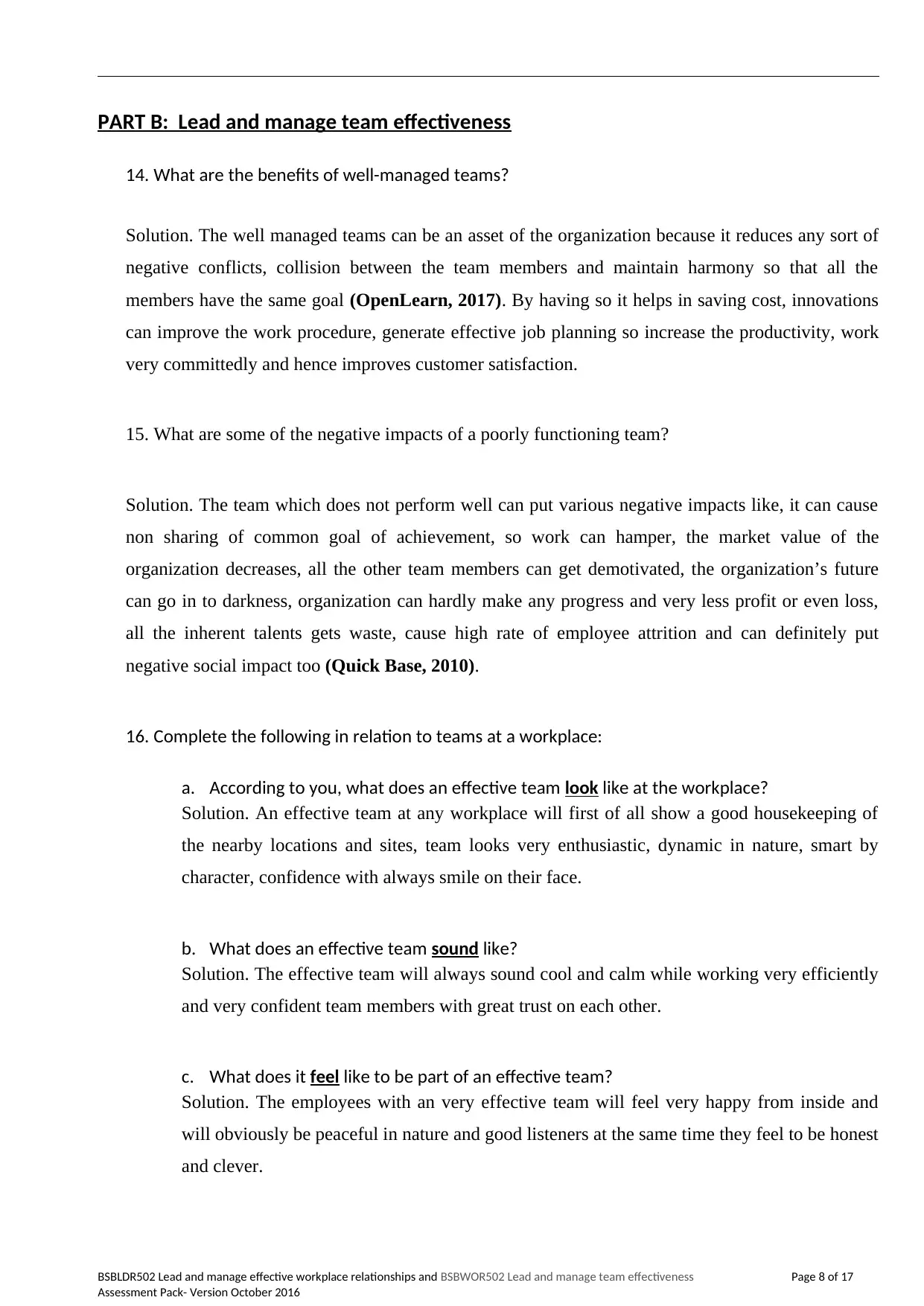
PART B: Lead and manage team effectiveness
14. What are the benefits of well-managed teams?
Solution. The well managed teams can be an asset of the organization because it reduces any sort of
negative conflicts, collision between the team members and maintain harmony so that all the
members have the same goal (OpenLearn, 2017). By having so it helps in saving cost, innovations
can improve the work procedure, generate effective job planning so increase the productivity, work
very committedly and hence improves customer satisfaction.
15. What are some of the negative impacts of a poorly functioning team?
Solution. The team which does not perform well can put various negative impacts like, it can cause
non sharing of common goal of achievement, so work can hamper, the market value of the
organization decreases, all the other team members can get demotivated, the organization’s future
can go in to darkness, organization can hardly make any progress and very less profit or even loss,
all the inherent talents gets waste, cause high rate of employee attrition and can definitely put
negative social impact too (Quick Base, 2010).
16. Complete the following in relation to teams at a workplace:
a. According to you, what does an effective team look like at the workplace?
Solution. An effective team at any workplace will first of all show a good housekeeping of
the nearby locations and sites, team looks very enthusiastic, dynamic in nature, smart by
character, confidence with always smile on their face.
b. What does an effective team sound like?
Solution. The effective team will always sound cool and calm while working very efficiently
and very confident team members with great trust on each other.
c. What does it feel like to be part of an effective team?
Solution. The employees with an very effective team will feel very happy from inside and
will obviously be peaceful in nature and good listeners at the same time they feel to be honest
and clever.
BSBLDR502 Lead and manage effective workplace relationships and BSBWOR502 Lead and manage team effectiveness
Assessment Pack- Version October 2016
Page 8 of 17
14. What are the benefits of well-managed teams?
Solution. The well managed teams can be an asset of the organization because it reduces any sort of
negative conflicts, collision between the team members and maintain harmony so that all the
members have the same goal (OpenLearn, 2017). By having so it helps in saving cost, innovations
can improve the work procedure, generate effective job planning so increase the productivity, work
very committedly and hence improves customer satisfaction.
15. What are some of the negative impacts of a poorly functioning team?
Solution. The team which does not perform well can put various negative impacts like, it can cause
non sharing of common goal of achievement, so work can hamper, the market value of the
organization decreases, all the other team members can get demotivated, the organization’s future
can go in to darkness, organization can hardly make any progress and very less profit or even loss,
all the inherent talents gets waste, cause high rate of employee attrition and can definitely put
negative social impact too (Quick Base, 2010).
16. Complete the following in relation to teams at a workplace:
a. According to you, what does an effective team look like at the workplace?
Solution. An effective team at any workplace will first of all show a good housekeeping of
the nearby locations and sites, team looks very enthusiastic, dynamic in nature, smart by
character, confidence with always smile on their face.
b. What does an effective team sound like?
Solution. The effective team will always sound cool and calm while working very efficiently
and very confident team members with great trust on each other.
c. What does it feel like to be part of an effective team?
Solution. The employees with an very effective team will feel very happy from inside and
will obviously be peaceful in nature and good listeners at the same time they feel to be honest
and clever.
BSBLDR502 Lead and manage effective workplace relationships and BSBWOR502 Lead and manage team effectiveness
Assessment Pack- Version October 2016
Page 8 of 17
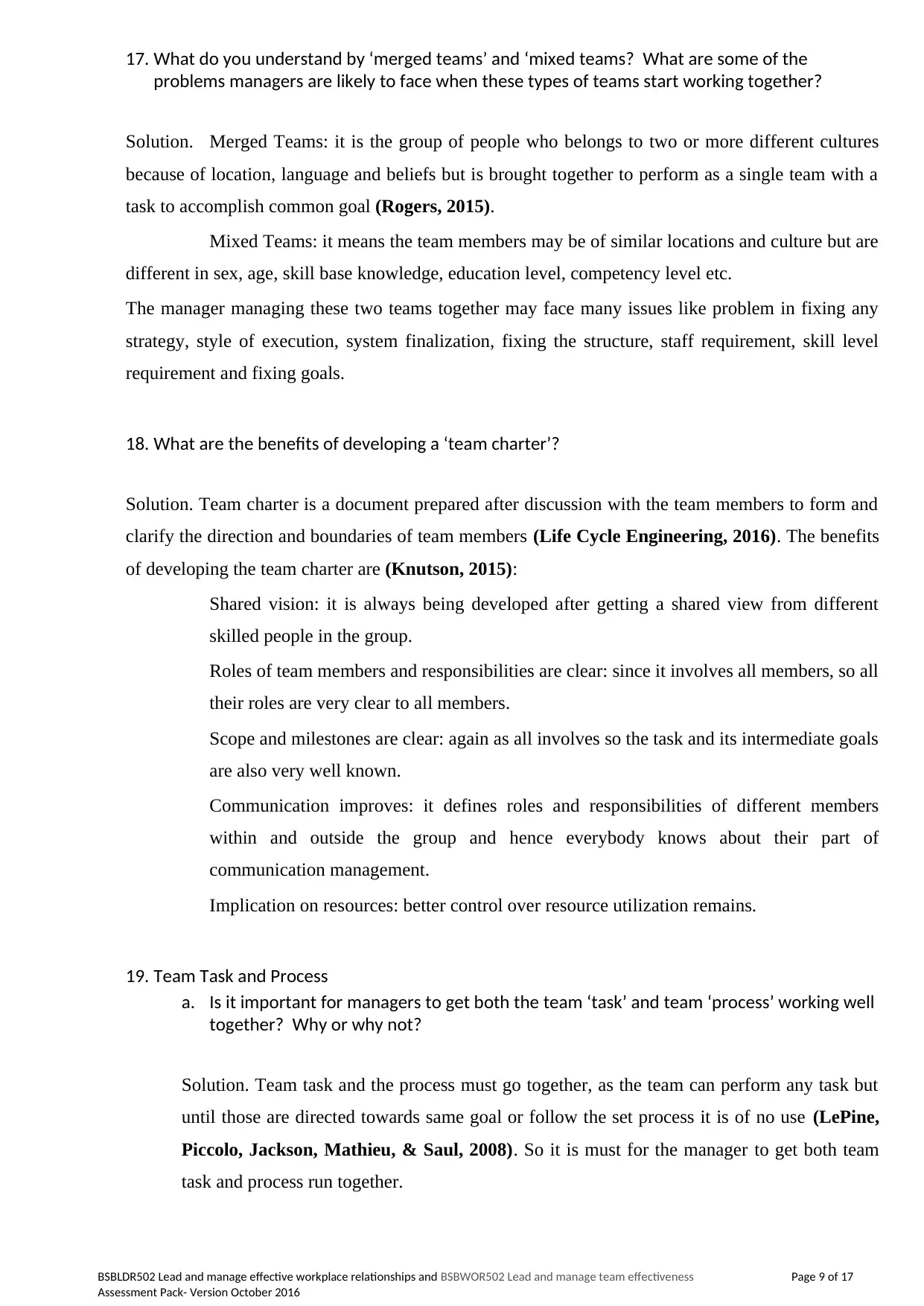
17. What do you understand by ‘merged teams’ and ‘mixed teams? What are some of the
problems managers are likely to face when these types of teams start working together?
Solution. Merged Teams: it is the group of people who belongs to two or more different cultures
because of location, language and beliefs but is brought together to perform as a single team with a
task to accomplish common goal (Rogers, 2015).
Mixed Teams: it means the team members may be of similar locations and culture but are
different in sex, age, skill base knowledge, education level, competency level etc.
The manager managing these two teams together may face many issues like problem in fixing any
strategy, style of execution, system finalization, fixing the structure, staff requirement, skill level
requirement and fixing goals.
18. What are the benefits of developing a ‘team charter’?
Solution. Team charter is a document prepared after discussion with the team members to form and
clarify the direction and boundaries of team members (Life Cycle Engineering, 2016). The benefits
of developing the team charter are (Knutson, 2015):
Shared vision: it is always being developed after getting a shared view from different
skilled people in the group.
Roles of team members and responsibilities are clear: since it involves all members, so all
their roles are very clear to all members.
Scope and milestones are clear: again as all involves so the task and its intermediate goals
are also very well known.
Communication improves: it defines roles and responsibilities of different members
within and outside the group and hence everybody knows about their part of
communication management.
Implication on resources: better control over resource utilization remains.
19. Team Task and Process
a. Is it important for managers to get both the team ‘task’ and team ‘process’ working well
together? Why or why not?
Solution. Team task and the process must go together, as the team can perform any task but
until those are directed towards same goal or follow the set process it is of no use (LePine,
Piccolo, Jackson, Mathieu, & Saul, 2008). So it is must for the manager to get both team
task and process run together.
BSBLDR502 Lead and manage effective workplace relationships and BSBWOR502 Lead and manage team effectiveness
Assessment Pack- Version October 2016
Page 9 of 17
problems managers are likely to face when these types of teams start working together?
Solution. Merged Teams: it is the group of people who belongs to two or more different cultures
because of location, language and beliefs but is brought together to perform as a single team with a
task to accomplish common goal (Rogers, 2015).
Mixed Teams: it means the team members may be of similar locations and culture but are
different in sex, age, skill base knowledge, education level, competency level etc.
The manager managing these two teams together may face many issues like problem in fixing any
strategy, style of execution, system finalization, fixing the structure, staff requirement, skill level
requirement and fixing goals.
18. What are the benefits of developing a ‘team charter’?
Solution. Team charter is a document prepared after discussion with the team members to form and
clarify the direction and boundaries of team members (Life Cycle Engineering, 2016). The benefits
of developing the team charter are (Knutson, 2015):
Shared vision: it is always being developed after getting a shared view from different
skilled people in the group.
Roles of team members and responsibilities are clear: since it involves all members, so all
their roles are very clear to all members.
Scope and milestones are clear: again as all involves so the task and its intermediate goals
are also very well known.
Communication improves: it defines roles and responsibilities of different members
within and outside the group and hence everybody knows about their part of
communication management.
Implication on resources: better control over resource utilization remains.
19. Team Task and Process
a. Is it important for managers to get both the team ‘task’ and team ‘process’ working well
together? Why or why not?
Solution. Team task and the process must go together, as the team can perform any task but
until those are directed towards same goal or follow the set process it is of no use (LePine,
Piccolo, Jackson, Mathieu, & Saul, 2008). So it is must for the manager to get both team
task and process run together.
BSBLDR502 Lead and manage effective workplace relationships and BSBWOR502 Lead and manage team effectiveness
Assessment Pack- Version October 2016
Page 9 of 17
⊘ This is a preview!⊘
Do you want full access?
Subscribe today to unlock all pages.

Trusted by 1+ million students worldwide
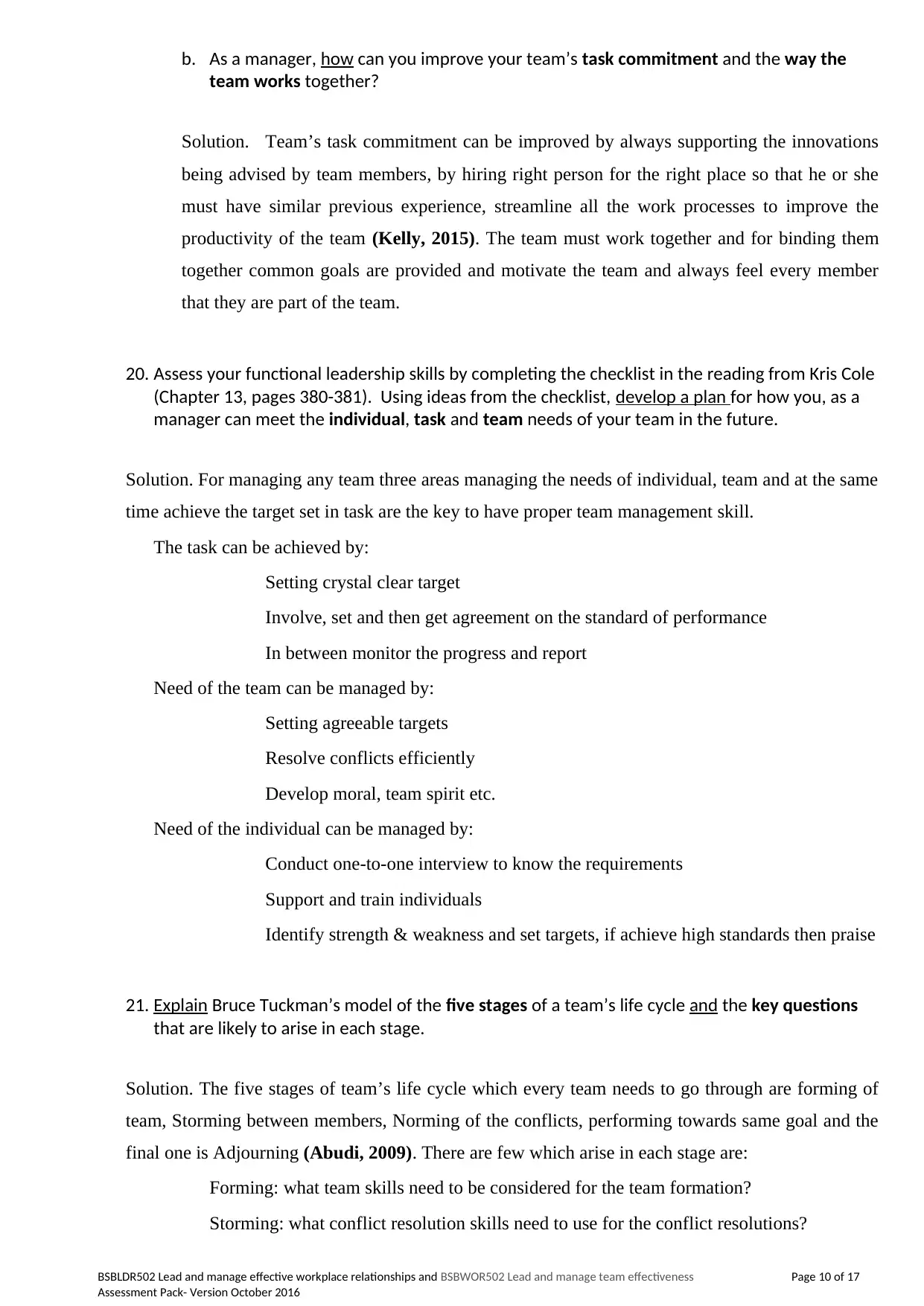
b. As a manager, how can you improve your team’s task commitment and the way the
team works together?
Solution. Team’s task commitment can be improved by always supporting the innovations
being advised by team members, by hiring right person for the right place so that he or she
must have similar previous experience, streamline all the work processes to improve the
productivity of the team (Kelly, 2015). The team must work together and for binding them
together common goals are provided and motivate the team and always feel every member
that they are part of the team.
20. Assess your functional leadership skills by completing the checklist in the reading from Kris Cole
(Chapter 13, pages 380-381). Using ideas from the checklist, develop a plan for how you, as a
manager can meet the individual, task and team needs of your team in the future.
Solution. For managing any team three areas managing the needs of individual, team and at the same
time achieve the target set in task are the key to have proper team management skill.
The task can be achieved by:
Setting crystal clear target
Involve, set and then get agreement on the standard of performance
In between monitor the progress and report
Need of the team can be managed by:
Setting agreeable targets
Resolve conflicts efficiently
Develop moral, team spirit etc.
Need of the individual can be managed by:
Conduct one-to-one interview to know the requirements
Support and train individuals
Identify strength & weakness and set targets, if achieve high standards then praise
21. Explain Bruce Tuckman’s model of the five stages of a team’s life cycle and the key questions
that are likely to arise in each stage.
Solution. The five stages of team’s life cycle which every team needs to go through are forming of
team, Storming between members, Norming of the conflicts, performing towards same goal and the
final one is Adjourning (Abudi, 2009). There are few which arise in each stage are:
Forming: what team skills need to be considered for the team formation?
Storming: what conflict resolution skills need to use for the conflict resolutions?
BSBLDR502 Lead and manage effective workplace relationships and BSBWOR502 Lead and manage team effectiveness
Assessment Pack- Version October 2016
Page 10 of 17
team works together?
Solution. Team’s task commitment can be improved by always supporting the innovations
being advised by team members, by hiring right person for the right place so that he or she
must have similar previous experience, streamline all the work processes to improve the
productivity of the team (Kelly, 2015). The team must work together and for binding them
together common goals are provided and motivate the team and always feel every member
that they are part of the team.
20. Assess your functional leadership skills by completing the checklist in the reading from Kris Cole
(Chapter 13, pages 380-381). Using ideas from the checklist, develop a plan for how you, as a
manager can meet the individual, task and team needs of your team in the future.
Solution. For managing any team three areas managing the needs of individual, team and at the same
time achieve the target set in task are the key to have proper team management skill.
The task can be achieved by:
Setting crystal clear target
Involve, set and then get agreement on the standard of performance
In between monitor the progress and report
Need of the team can be managed by:
Setting agreeable targets
Resolve conflicts efficiently
Develop moral, team spirit etc.
Need of the individual can be managed by:
Conduct one-to-one interview to know the requirements
Support and train individuals
Identify strength & weakness and set targets, if achieve high standards then praise
21. Explain Bruce Tuckman’s model of the five stages of a team’s life cycle and the key questions
that are likely to arise in each stage.
Solution. The five stages of team’s life cycle which every team needs to go through are forming of
team, Storming between members, Norming of the conflicts, performing towards same goal and the
final one is Adjourning (Abudi, 2009). There are few which arise in each stage are:
Forming: what team skills need to be considered for the team formation?
Storming: what conflict resolution skills need to use for the conflict resolutions?
BSBLDR502 Lead and manage effective workplace relationships and BSBWOR502 Lead and manage team effectiveness
Assessment Pack- Version October 2016
Page 10 of 17
Paraphrase This Document
Need a fresh take? Get an instant paraphrase of this document with our AI Paraphraser
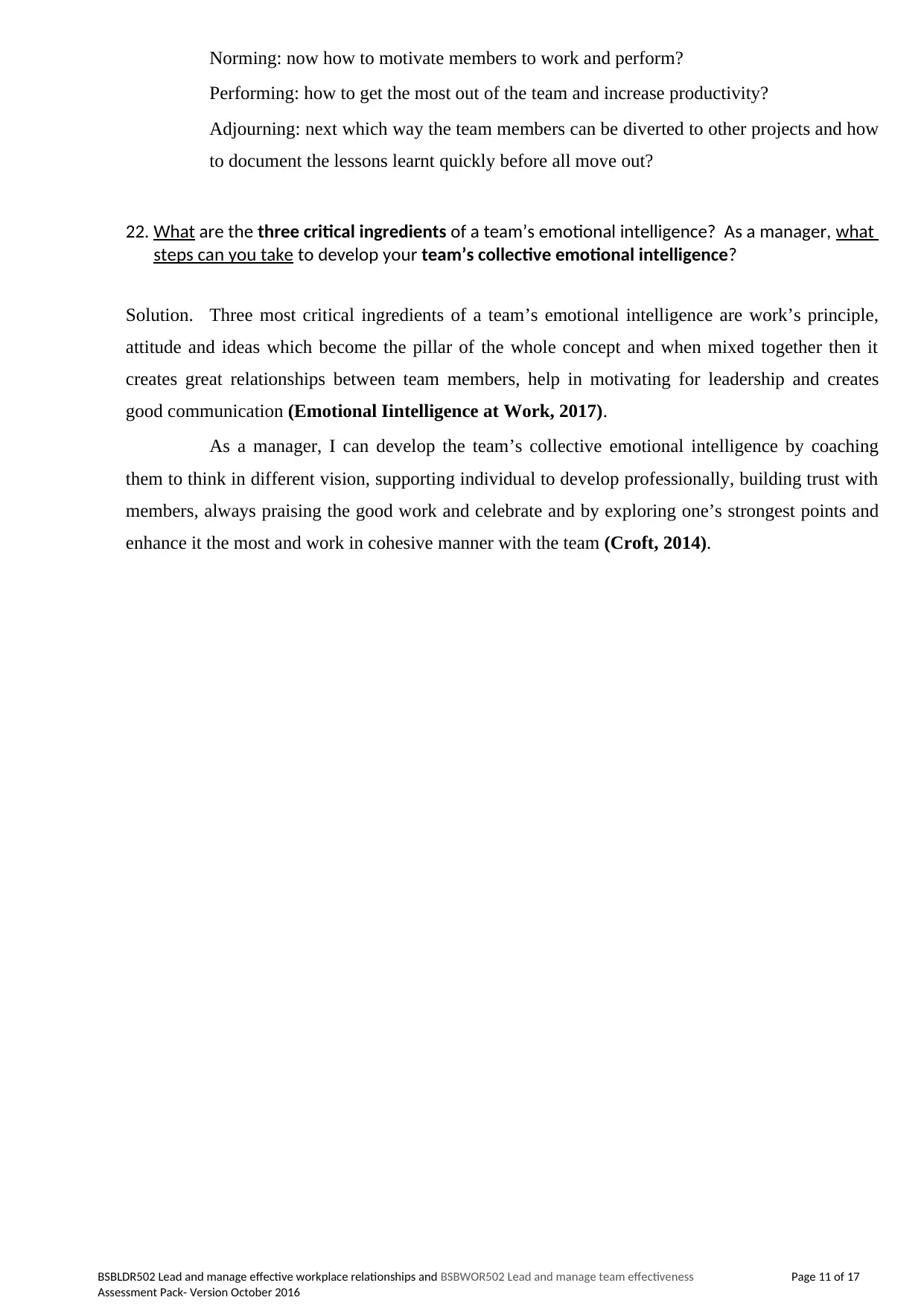
Norming: now how to motivate members to work and perform?
Performing: how to get the most out of the team and increase productivity?
Adjourning: next which way the team members can be diverted to other projects and how
to document the lessons learnt quickly before all move out?
22. What are the three critical ingredients of a team’s emotional intelligence? As a manager, what
steps can you take to develop your team’s collective emotional intelligence?
Solution. Three most critical ingredients of a team’s emotional intelligence are work’s principle,
attitude and ideas which become the pillar of the whole concept and when mixed together then it
creates great relationships between team members, help in motivating for leadership and creates
good communication (Emotional Iintelligence at Work, 2017).
As a manager, I can develop the team’s collective emotional intelligence by coaching
them to think in different vision, supporting individual to develop professionally, building trust with
members, always praising the good work and celebrate and by exploring one’s strongest points and
enhance it the most and work in cohesive manner with the team (Croft, 2014).
BSBLDR502 Lead and manage effective workplace relationships and BSBWOR502 Lead and manage team effectiveness
Assessment Pack- Version October 2016
Page 11 of 17
Performing: how to get the most out of the team and increase productivity?
Adjourning: next which way the team members can be diverted to other projects and how
to document the lessons learnt quickly before all move out?
22. What are the three critical ingredients of a team’s emotional intelligence? As a manager, what
steps can you take to develop your team’s collective emotional intelligence?
Solution. Three most critical ingredients of a team’s emotional intelligence are work’s principle,
attitude and ideas which become the pillar of the whole concept and when mixed together then it
creates great relationships between team members, help in motivating for leadership and creates
good communication (Emotional Iintelligence at Work, 2017).
As a manager, I can develop the team’s collective emotional intelligence by coaching
them to think in different vision, supporting individual to develop professionally, building trust with
members, always praising the good work and celebrate and by exploring one’s strongest points and
enhance it the most and work in cohesive manner with the team (Croft, 2014).
BSBLDR502 Lead and manage effective workplace relationships and BSBWOR502 Lead and manage team effectiveness
Assessment Pack- Version October 2016
Page 11 of 17
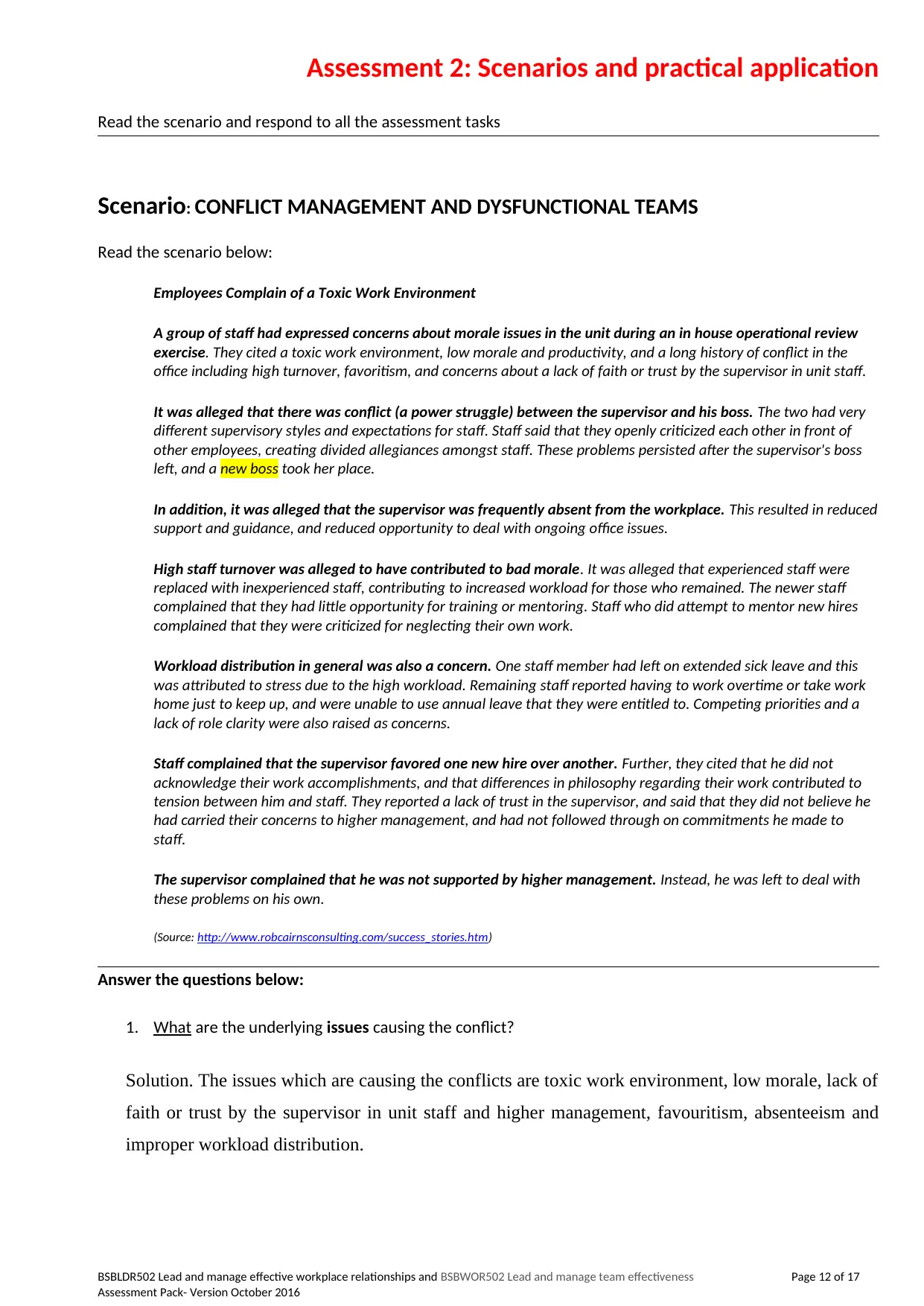
Assessment 2: Scenarios and practical application
Read the scenario and respond to all the assessment tasks
Scenario: CONFLICT MANAGEMENT AND DYSFUNCTIONAL TEAMS
Read the scenario below:
Employees Complain of a Toxic Work Environment
A group of staff had expressed concerns about morale issues in the unit during an in house operational review
exercise. They cited a toxic work environment, low morale and productivity, and a long history of conflict in the
office including high turnover, favoritism, and concerns about a lack of faith or trust by the supervisor in unit staff.
It was alleged that there was conflict (a power struggle) between the supervisor and his boss. The two had very
different supervisory styles and expectations for staff. Staff said that they openly criticized each other in front of
other employees, creating divided allegiances amongst staff. These problems persisted after the supervisor's boss
left, and a new boss took her place.
In addition, it was alleged that the supervisor was frequently absent from the workplace. This resulted in reduced
support and guidance, and reduced opportunity to deal with ongoing office issues.
High staff turnover was alleged to have contributed to bad morale. It was alleged that experienced staff were
replaced with inexperienced staff, contributing to increased workload for those who remained. The newer staff
complained that they had little opportunity for training or mentoring. Staff who did attempt to mentor new hires
complained that they were criticized for neglecting their own work.
Workload distribution in general was also a concern. One staff member had left on extended sick leave and this
was attributed to stress due to the high workload. Remaining staff reported having to work overtime or take work
home just to keep up, and were unable to use annual leave that they were entitled to. Competing priorities and a
lack of role clarity were also raised as concerns.
Staff complained that the supervisor favored one new hire over another. Further, they cited that he did not
acknowledge their work accomplishments, and that differences in philosophy regarding their work contributed to
tension between him and staff. They reported a lack of trust in the supervisor, and said that they did not believe he
had carried their concerns to higher management, and had not followed through on commitments he made to
staff.
The supervisor complained that he was not supported by higher management. Instead, he was left to deal with
these problems on his own.
(Source: http://www.robcairnsconsulting.com/success_stories.htm)
Answer the questions below:
1. What are the underlying issues causing the conflict?
Solution. The issues which are causing the conflicts are toxic work environment, low morale, lack of
faith or trust by the supervisor in unit staff and higher management, favouritism, absenteeism and
improper workload distribution.
BSBLDR502 Lead and manage effective workplace relationships and BSBWOR502 Lead and manage team effectiveness
Assessment Pack- Version October 2016
Page 12 of 17
Read the scenario and respond to all the assessment tasks
Scenario: CONFLICT MANAGEMENT AND DYSFUNCTIONAL TEAMS
Read the scenario below:
Employees Complain of a Toxic Work Environment
A group of staff had expressed concerns about morale issues in the unit during an in house operational review
exercise. They cited a toxic work environment, low morale and productivity, and a long history of conflict in the
office including high turnover, favoritism, and concerns about a lack of faith or trust by the supervisor in unit staff.
It was alleged that there was conflict (a power struggle) between the supervisor and his boss. The two had very
different supervisory styles and expectations for staff. Staff said that they openly criticized each other in front of
other employees, creating divided allegiances amongst staff. These problems persisted after the supervisor's boss
left, and a new boss took her place.
In addition, it was alleged that the supervisor was frequently absent from the workplace. This resulted in reduced
support and guidance, and reduced opportunity to deal with ongoing office issues.
High staff turnover was alleged to have contributed to bad morale. It was alleged that experienced staff were
replaced with inexperienced staff, contributing to increased workload for those who remained. The newer staff
complained that they had little opportunity for training or mentoring. Staff who did attempt to mentor new hires
complained that they were criticized for neglecting their own work.
Workload distribution in general was also a concern. One staff member had left on extended sick leave and this
was attributed to stress due to the high workload. Remaining staff reported having to work overtime or take work
home just to keep up, and were unable to use annual leave that they were entitled to. Competing priorities and a
lack of role clarity were also raised as concerns.
Staff complained that the supervisor favored one new hire over another. Further, they cited that he did not
acknowledge their work accomplishments, and that differences in philosophy regarding their work contributed to
tension between him and staff. They reported a lack of trust in the supervisor, and said that they did not believe he
had carried their concerns to higher management, and had not followed through on commitments he made to
staff.
The supervisor complained that he was not supported by higher management. Instead, he was left to deal with
these problems on his own.
(Source: http://www.robcairnsconsulting.com/success_stories.htm)
Answer the questions below:
1. What are the underlying issues causing the conflict?
Solution. The issues which are causing the conflicts are toxic work environment, low morale, lack of
faith or trust by the supervisor in unit staff and higher management, favouritism, absenteeism and
improper workload distribution.
BSBLDR502 Lead and manage effective workplace relationships and BSBWOR502 Lead and manage team effectiveness
Assessment Pack- Version October 2016
Page 12 of 17
⊘ This is a preview!⊘
Do you want full access?
Subscribe today to unlock all pages.

Trusted by 1+ million students worldwide
1 out of 17
Related Documents
Your All-in-One AI-Powered Toolkit for Academic Success.
+13062052269
info@desklib.com
Available 24*7 on WhatsApp / Email
![[object Object]](/_next/static/media/star-bottom.7253800d.svg)
Unlock your academic potential
Copyright © 2020–2025 A2Z Services. All Rights Reserved. Developed and managed by ZUCOL.





